Do's and Dont's When Visiting Barcelona, Spain
Insider tips for what to do and what to avoid when visiting Barcelona, Spain.
1. Do Adjust Your Schedule and Live a Latin Lifestyle, Don't Stick to Your Usual Routine
Barcelona embraces the Latin lifestyle of leisurely mornings, mid-afternoon siestas, and late dinners. It's not uncommon for streets to be deserted before 9am, stores closed between 3pm and 5pm, and restaurants opening for dinner at 8pm at the earliest.
If you stick to an American schedule of rising at dawn, eating an early breakfast, shopping in the afternoon, and dining in the early evening - at best - you'll miss out on some of the charms of Barcelona. At worst, you'll be extremely hungry, tired, frustrated and generally feel out-of-sync with the world around you.
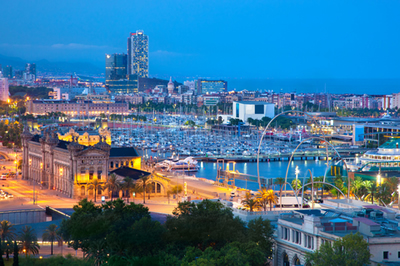
Take a siesta in the afternoon, then explore Barcelona at night. Museums, shops and other attractions are open in the evenings.
Since the time change between Spain and the United States disrupts your sleep schedule anyway, plan to reset your body on a Barcelona rhythm. Adjust your schedule to rise around 9am, explore the city between 9am and noon, take a nap or relax between noon and 3pm, return to sightseeing or shopping (most stores and museums stay open to at least 9pm), then plan on eating dinner around 10pm. You'll be amazed at how refreshing alternating between activity and rest throughout the day is compared to the non-stop rhythm between 8am and 6pm you may experience at home.
2. Do Use Credit Cards, Don't Forget a Photo ID
You'll get the best exchange rate by charging meals and purchases on your credit card. When using credit cards, make sure you have a photo ID. Spanish law requires that you provide a Photo ID at the time of purchase. A US Driver's License is accepted - there is no need to carry your passport with you.
Also, always carry some euros in cash. Credit card use is not as widespread in restaurants, cafes, and shops as it is in other European cities, like Paris or London. Have some cash on hand to pay if credit cards are not accepted.
3. Do Eat Paella, Don't Forget to Share with a Friend
Paella, a traditional Spanish dish consisting of rice, saffron, olive oil mixed with various meats, fish and shellfish, is a must-eat on your trip to Barcelona. Paella is cooked and served from a large, round, shallow pan.

Paella is made to order for two or more people to share.
At most restaurants, Paella is prepared to order, brought to the table in the pan, then the waiter serves it onto your plate. Since paellas are a large dish prepared from scratch, order the dish for at least two people to share. Expect to pay around 30-40€ per paella.
In touristy-areas, such as on the waterfront on Passage de Joan Borbo and on Las Ramblas, you'll see signs displaying the various types of Paella outside restaurants. Avoid any restaurant advertising "Paellador" paella like in the photo below.

Avoid restaurants advertising Paellador paella.
This brand of Paella is frozen, then defrosted for single servings. Instead, walk a view blocks off the tourist-track for an authentic and delicious meal. Try the fresh seafood versions - a Barcelona specialty.
4. Do Visit Churches, Don't Go in a Sleeveless Top or Shorts
Covering your shoulders and legs is a traditional sign of respect in religious settings. When visiting churches in Barcelona, especially at the Barcelona Cathedral, this tradition is strictly enforced by guards at the door.
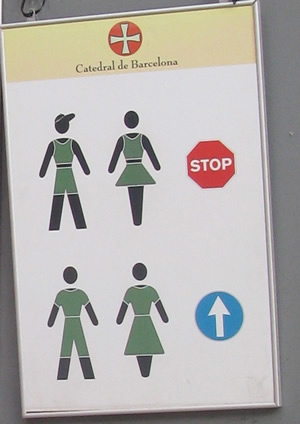
Cover your shoulders and legs when visiting the Barcelona Cathedral.
Don't try to hide your shoulders and legs under maps and pages from tour books - trust us, this doesn't work. On hot days, toss a lightweight scarf in your bag. Drape the scarf over your shoulders or tied around your legs for entrance into churches and cathedrals.
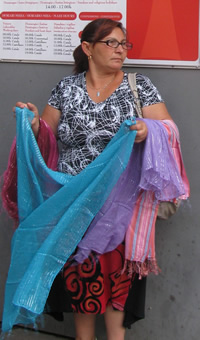
Wearing a tank top and shorts? Maybe, you'll get lucky and you can purchase a scarf from the enterprising street vendors that hang out in front of the Cathedral.
5. Do Order Cava, Don't Order Sangria
When you think of Spanish drinks, you probably think of Sangria. Sangria is the local drink in the southern regions of Spain, such as Andalucia and the city of Valencia, where the fruit is picked fresh from the vine and mixed with simple sugars and red wine.
In Barcelona, Sangria is served in most bars and restaurants due to its appeal to tourists. The Sangria you'll drink in Barcelona is usually a combination of leftover red wine with some fruit and Sprite mixed in. It's as similar to "real" Sangria as grape juice is to an aged Cabernet Sauvignon.

Sangria is a drink popular in Southern Spain - not in Barcelona. 1
Instead of Sangria, order a glass of Cava. Cava is a sparkling wine similar to Champagne produced in the Penedès region less than 50 miles from Barcelona. Cava is the "unofficial" drink of Barcelona and is reasonably priced at 4-6€ a glass.
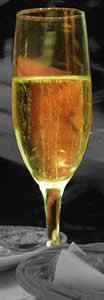 2
2
Pass on the Sangria, live like the locals and lounge at a sidewalk cafe sipping from a flute of sparkling Cava.
6. Do Ride the Metro, Don't Ride the City Tourist Bus
When visiting Barcelona, you may be tempted to ride the Barcelona Bus Turistic, the hop-on and hop-off double-decker tour bus, to easily navigate between tourist attractions. Pass on the bus, and instead take the Metro.
Here's three reasons why:
Traffic - Barcelona is a sprawling city with major tourist attractions spread out over a large geographical area. During peak traffic times, you'll sit in traffic and wait through numerous red lights to arrive at your destination. If you're unlucky in the summer, you'll sit on the open-air top level and breathe in traffic fumes. Why waste precious vacation time on the bus, when you can whisk across town in a fraction of the time on the air-conditioned Barcelona Metro?
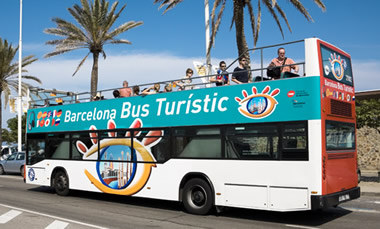
Save time and money by taking the metro instead of the Barcelona Bus Turistic.
Expense - The tourist bus is expensive with one-day adult tickets priced at a jaw-dropping 24€ per adult and 14€ per child. A one-way Barcelona Metro ticket costs 1.40€ per trip, an unlimited day pass (T-Dia) costs 5.90€ and a ticket for 10 rides (called a T-10) shared between two or more people costs 7.85€.
Local-Flavor - Riding the metro, you'll mix with the locals and see more of the city by walking from the metro to your destination. On the tourist bus, you'll be surrounded by English speaking passengers and dropped off directly in front of your tourist destination.
At first thought, this may sound wonderful. But, one of the best ways to see any city is on foot. Exit your station and meander to your destination. Explore green spaces, stop at interesting shops and join the crowd for a quick pinxto at a local cafe. On the tourist bus, you may miss these local experiences, which are often more memorable than the churches or museums you are planning to visit.

Ride the modern, air conditioned Barcelona Metro instead of the tourist bus.
7. Do Sightsee, Don't Be Paranoid about Pickpockets
Pickpockets look for easy marks, so if you take some common sense precautions, thieves will pass you by. If you are aware of your surroundings and take a few precautions, you won't need to wear a bulky money belt. Instead:
- When sightseeing for the day, leave extra cash, credit cards and passports in a hotel safe. Only carry what you need for the day.
- For men, avoid putting valuables in a backpack and keep your wallet in your front pocket.
- For women, wear a cross-body purse, keeping it hanging in front by your abdomen. If you are in a large crowd with a lot of jostling, place your hand across your purse's zippered opening.
- Place bags and cameras on your lap when sitting at a sidewalk cafe. Don't leave valuables sitting on the table or hanging on the back of your chair.
Photo Credits:
1 Tamorlan Wiki Commons
2 Seidenstud Wiki Commons









